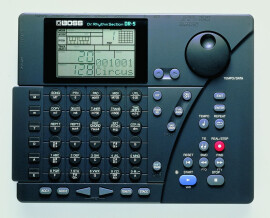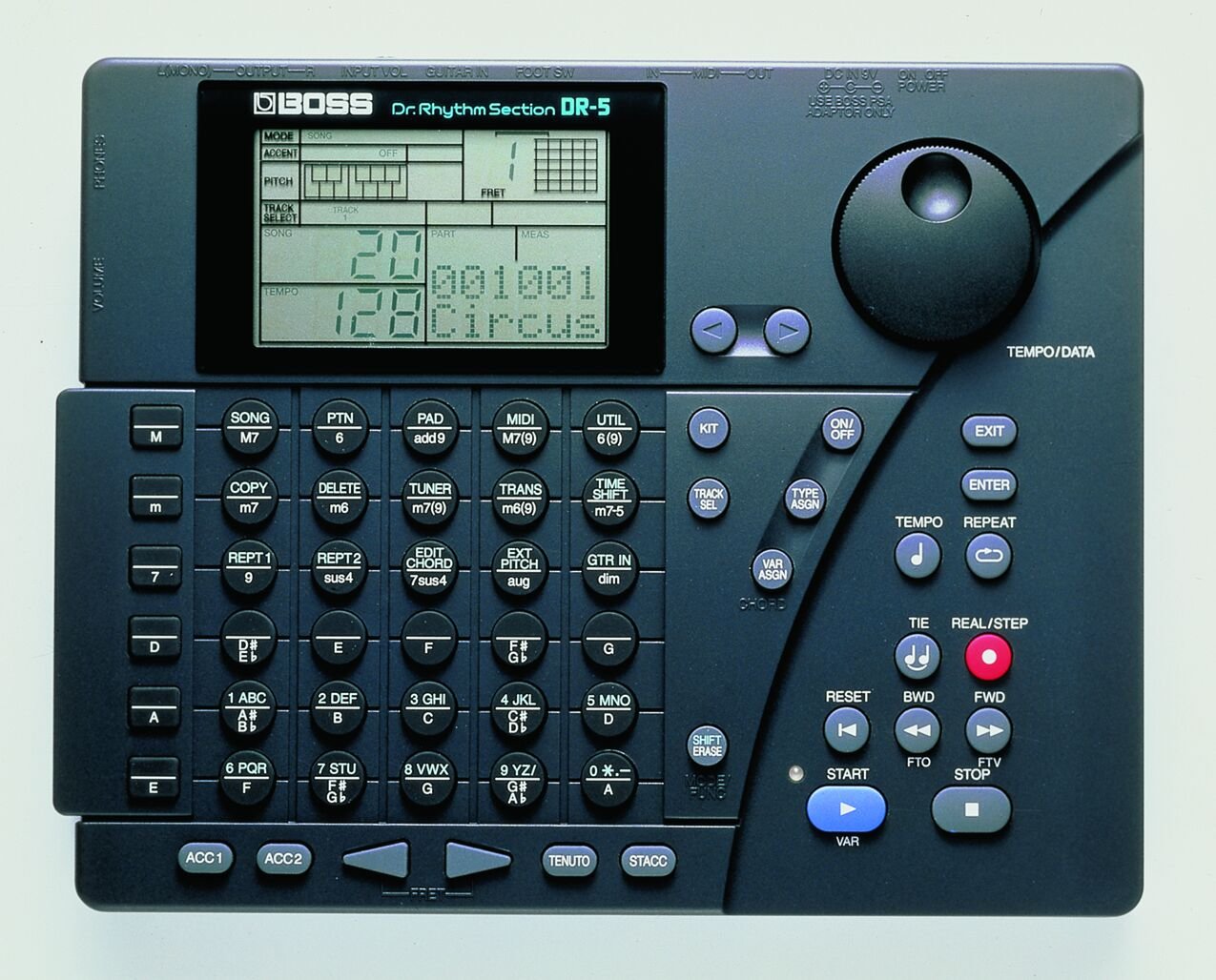View other reviews for this product:
« A great tool »
Published on 02/11/12 at 07:15The DR-5 manual is available online for more details, I simply remember the basics:
A midi in / out, 2 jack outputs 6.5, an input jack for guitar, a pedal input start / stop, a headphone jack.
4-track sequencer (one track drums, three tracks for the other instruments), 256 sounds total (82 for instruments, the rest for drums and percussion). It works on 9V power supply or batteries.
No effects (you can simply adjust the pitch and decay), no possibility of editing sounds.
It has almost everything at hand to write, I just regret that the velocity (volume of the notes) is not recognized by the sequencer (mode expander with a MIDI keyboard, it works, but the sequencer takes only 3 volumes ).
UTILIZATION
The manual is clear and simple setup. The 36 pads are all a function, so we found it very quickly. Those who have already been working on the BAR Boss can even do without the manual to create a simple rhythm. The editing options are few, one can learn most functions in one day.
The sequencer is really nice, you can record in real time or step by step. On screen, it has a keyboard and fretboard to better identify the notes being played. The organization of the pads has been designed for guitarists, very handy when one has no basis in music theory.
The guitar input lets you record notes (DR-5 recognizes the note played and transcribed by noon, he does not record audio), but the system is a bit wobbly and it is not very practical to use (we often end up with an offbeat tempo and you can not play fast or risk seeing half of the notes will not be saved)
SOUNDS
The sounds have aged, but they are realistic in the sense that it still manages to recognize a piano of a guitar. The expression is limited, since as I said above, it receives only 3 volumes. Everything sounds right, nothing more. The drum sounds are more than correct for its time (late 90s), especially compared to the price of the new machine.
I said that if it still is great for work, do not you use it for studio recording, it is anyway not think to.
OVERALL OPINION
I used this machine for many years since its release, before selling in 2001, then buy it back again 3 years ago. There has been nothing like it on the market, this is why I use it always.
I tested many machines, Roland (Groovebox) and Yamaha (QY series) mainly. The Groovebox do not have a sound general, and if the MC 909 or 808 can get sounds better bill by adding expansion cards, it is far from a portable configuration (it does not work on battery , and given the size of this machine is anyway impossible to use on the move). The Yamaha sound better sometimes, but ergonomics issue is not really that.
This is an excellent machine for Laying out, really intuitive, and allows to focus solely on music. I even used Live for a few years since I used as a sequencer to trigger loops on my sampler, and an expander control (great for MIDI, so even if it sometimes takes a little tweaking).
The most:
- Transportable thanks to its battery power
- Panel of various sounds, although it is far from the quality of sound banks current
- Simplicity when it comes to transcribe a terrible idea. I can not count the pieces that I composed from this machine.
Cons:
- The limited expression
- Limited memory (200 patterns, 20 songs)
I have long sought an equivalent machine after it was sold second-hand. Having found nothing as simple and light, so I bought this machine and I found this easier to transcribe an idea very quickly. I also always wondered why manufacturers had abandoned the idea of a machine with a small sequencer and sound generalist who can ship everywhere.
The value for money was excellent in nine at the time (the Yamaha cost far more expensive, it must be remembered), and still is used.
Clearly, with current technology, one could easily imagine a DR-6 with more memory for sounds (when you see what you do with a few MB, there are ways to do something decent with very little memory ) and a USB port or a memory card slot to store easily.
Tell Mr. Boss, we leave you when your DR-6???
A midi in / out, 2 jack outputs 6.5, an input jack for guitar, a pedal input start / stop, a headphone jack.
4-track sequencer (one track drums, three tracks for the other instruments), 256 sounds total (82 for instruments, the rest for drums and percussion). It works on 9V power supply or batteries.
No effects (you can simply adjust the pitch and decay), no possibility of editing sounds.
It has almost everything at hand to write, I just regret that the velocity (volume of the notes) is not recognized by the sequencer (mode expander with a MIDI keyboard, it works, but the sequencer takes only 3 volumes ).
UTILIZATION
The manual is clear and simple setup. The 36 pads are all a function, so we found it very quickly. Those who have already been working on the BAR Boss can even do without the manual to create a simple rhythm. The editing options are few, one can learn most functions in one day.
The sequencer is really nice, you can record in real time or step by step. On screen, it has a keyboard and fretboard to better identify the notes being played. The organization of the pads has been designed for guitarists, very handy when one has no basis in music theory.
The guitar input lets you record notes (DR-5 recognizes the note played and transcribed by noon, he does not record audio), but the system is a bit wobbly and it is not very practical to use (we often end up with an offbeat tempo and you can not play fast or risk seeing half of the notes will not be saved)
SOUNDS
The sounds have aged, but they are realistic in the sense that it still manages to recognize a piano of a guitar. The expression is limited, since as I said above, it receives only 3 volumes. Everything sounds right, nothing more. The drum sounds are more than correct for its time (late 90s), especially compared to the price of the new machine.
I said that if it still is great for work, do not you use it for studio recording, it is anyway not think to.
OVERALL OPINION
I used this machine for many years since its release, before selling in 2001, then buy it back again 3 years ago. There has been nothing like it on the market, this is why I use it always.
I tested many machines, Roland (Groovebox) and Yamaha (QY series) mainly. The Groovebox do not have a sound general, and if the MC 909 or 808 can get sounds better bill by adding expansion cards, it is far from a portable configuration (it does not work on battery , and given the size of this machine is anyway impossible to use on the move). The Yamaha sound better sometimes, but ergonomics issue is not really that.
This is an excellent machine for Laying out, really intuitive, and allows to focus solely on music. I even used Live for a few years since I used as a sequencer to trigger loops on my sampler, and an expander control (great for MIDI, so even if it sometimes takes a little tweaking).
The most:
- Transportable thanks to its battery power
- Panel of various sounds, although it is far from the quality of sound banks current
- Simplicity when it comes to transcribe a terrible idea. I can not count the pieces that I composed from this machine.
Cons:
- The limited expression
- Limited memory (200 patterns, 20 songs)
I have long sought an equivalent machine after it was sold second-hand. Having found nothing as simple and light, so I bought this machine and I found this easier to transcribe an idea very quickly. I also always wondered why manufacturers had abandoned the idea of a machine with a small sequencer and sound generalist who can ship everywhere.
The value for money was excellent in nine at the time (the Yamaha cost far more expensive, it must be remembered), and still is used.
Clearly, with current technology, one could easily imagine a DR-6 with more memory for sounds (when you see what you do with a few MB, there are ways to do something decent with very little memory ) and a USB port or a memory card slot to store easily.
Tell Mr. Boss, we leave you when your DR-6???



